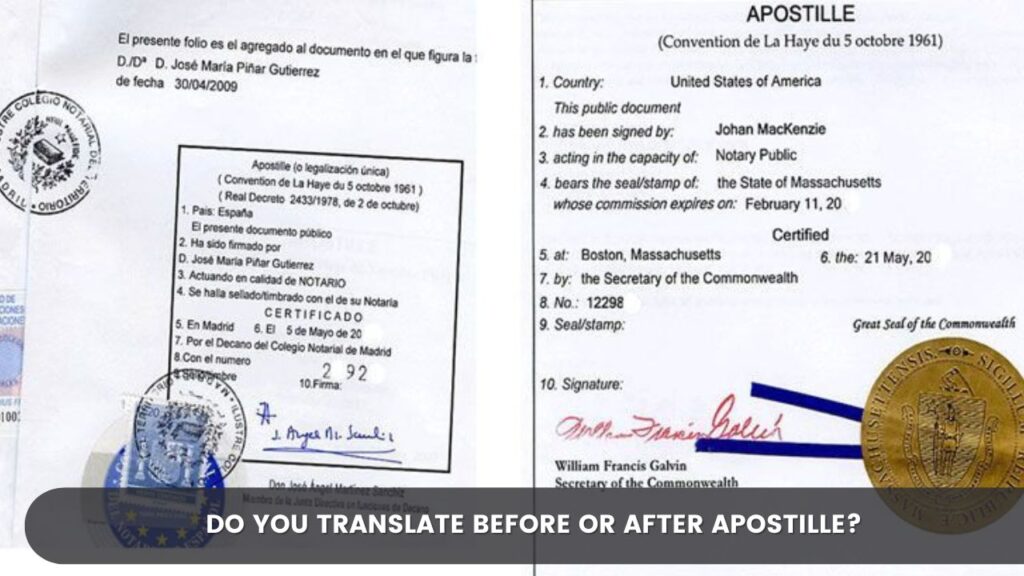When dealing with international documents, the question often arises: do you translate before or after apostille? This seemingly simple question can have significant implications for the validity and acceptance of your documents abroad. This comprehensive guide will delve into the nuances of translation and apostille processes, providing you with a clear understanding to ensure your documents are correctly prepared for international use.
Understanding Apostille
Definition
An apostille is a certification provided under the Hague Convention of 1961 for authenticating documents for use in foreign countries. It simplifies the process of legalizing documents by providing a standard format recognized by all member countries.
Purpose
The main purpose of an apostille is to certify the authenticity of the signature, the capacity in which the person signing the document has acted, and the identity of any stamp or seal affixed to the document.
Hague Convention
The Hague Convention Abolishing the Requirement of Legalisation for Foreign Public Documents, commonly known as the Apostille Convention, was established to streamline the process of document legalization for international use among member countries.
Understanding whether to translate before or after obtaining an apostille is crucial, and learning about what an apostille service is and its uses can provide valuable context to ensure your documents are processed correctly.
The Importance of Translation
Why Translate?
Translation ensures that the content of your documents is understood by the authorities in the destination country. It is crucial for legal, educational, and commercial documents to be accurately translated to avoid misunderstandings or legal issues.
Types of Documents
Documents that often require translation include birth certificates, marriage certificates, diplomas, transcripts, and business agreements.
Certified Translation
Certified translation means the translation has been performed by a professional translator and is accompanied by a statement attesting to the accuracy and completeness of the translation.
When determining the correct order of translation and apostille for international documents, it’s helpful to explore the specific procedures involved in obtaining an apostille for a passport in the US, as this will shed light on common steps and considerations.
Translation Before Apostille
Advantages
- Consistency: Ensures the content being apostilled is exactly what will be presented in the translated document.
- Clarity: Provides a clear, certified translation that matches the apostilled document.
Disadvantages
- Double Apostille: In some cases, you may need to apostille both the original and the translated documents, increasing costs.
- Time-Consuming: The process may take longer, as it involves translating and then apostilling the document.
Legal Requirements
Some countries require documents to be translated before they are apostilled, as the apostille certifies the translated document’s authenticity.
For those needing to understand the order of translation and apostille, particularly for vital records, examining the process of obtaining apostille services for birth certificates can provide insights into the requirements and ensure all necessary steps are followed accurately.
Translation After Apostille
Benefits
- Efficiency: Apostilling the original document before translation can be quicker and simpler.
- Cost-Effective: Often, you only need to apostille the original document, not the translation.
Drawbacks
- Inconsistency Risk: The translation might not perfectly match the apostilled document, leading to potential legal issues.
- Verification: Additional steps might be required to verify the translation’s accuracy.
Practical Scenarios
Translation after apostille is often used for documents where the original language is recognized and the translated version is merely for informational purposes.
Comparing Both Approaches
Cost
- Translation Before Apostille: May incur higher costs due to potential double apostille.
- Translation After Apostille: Generally more cost-effective, but may involve additional verification fees.
Time
- Translation Before Apostille: Longer processing time as both translation and apostille are required.
- Translation After Apostille: Faster, with fewer steps involved.
Accuracy
- Translation Before Apostille: Higher accuracy as the translated content is apostilled.
- Translation After Apostille: Potential for discrepancies between the apostilled document and its translation.
Legal Validity
- Translation Before Apostille: Often ensures higher legal validity in countries requiring certified translations.
- Translation After Apostille: Suitable for countries where apostille of the original document suffices.
Common Mistakes to Avoid
Missteps
- Incorrect Order: Confusing the order of translation and apostille can lead to invalid documents.
- Uncertified Translators: Using non-certified translators can result in inaccuracies.
- Missing Deadlines: Delays in processing can affect document validity.
Consequences
- Document Rejection: Incorrectly processed documents may be rejected by foreign authorities.
- Additional Costs: Rectifying mistakes can incur additional fees and time.
- Legal Issues: Inaccurate translations can lead to misunderstandings and legal complications.
Tips
- Research Requirements: Understand the specific requirements of the destination country.
- Hire Professionals: Use certified translation and apostille services.
- Plan Ahead: Allow ample time for processing to avoid last-minute issues.
Legal Requirements by Country
Country-Specific Rules
Each country has specific rules regarding the order of translation and apostille. For instance, some countries accept apostille of the original document, while others require the translation to be apostilled.
Examples
- United States: Generally, the apostille is obtained before translation.
- Germany: Often requires translation before apostille for official documents.
- China: Apostille is not recognized; documents need to be legalized through consular channels.
Variations
Understanding these variations is crucial to ensure compliance and avoid unnecessary delays.
Choosing a Translation Service
Criteria
When selecting a translation service, consider the following:
- Certification: Ensure the service offers certified translations.
- Experience: Look for services with experience in legal and official document translation.
- Reputation: Check reviews and testimonials.
Recommendations
Seek recommendations from legal professionals or use accredited translation services to ensure accuracy and reliability.
Certified Translators
Certified translators provide a statement attesting to the translation’s accuracy, which is often required for legal documents.
Document Types Requiring Apostille
Personal Documents
- Birth Certificates
- Marriage Certificates
- Death Certificates
Educational Documents
- Diplomas
- Transcripts
- Letters of Recommendation
Commercial Documents
- Business Agreements
- Articles of Incorporation
- Power of Attorney
Step-by-Step Apostille Process
Obtaining Apostille
- Identify the Document Type: Determine if the document is eligible for apostille.
- Notarization: Some documents may need notarization before apostille.
- Submit to Competent Authority: Submit the document to the appropriate authority for apostille.
Key Steps
- Prepare the Document: Ensure the document is complete and accurate.
- Notarization (if required): Get the document notarized by a notary public.
- Submission: Submit the document to the relevant authority for apostille.
- Receive Apostille: Collect the apostilled document once processed.
Necessary Documents
- Original Document
- Identification
- Payment of Fees
Step-by-Step Translation Process
Choosing a Translator
Select a certified translator experienced in the type of document you need translated.
Key Steps
- Select Translator: Choose a certified professional.
- Submit Document: Provide the document for translation.
- Review Translation: Check the accuracy of the translated document.
- Certification: Ensure the translation is certified.
Certification
The translator provides a statement verifying the translation’s accuracy and completeness.
Costs Involved
Apostille Fees
Fees vary by country and document type. Some authorities charge per document, while others may have a flat fee.
Translation Fees
Translation costs depend on the document length, complexity, and language pair. Certified translations typically cost more.
Hidden Costs
Consider additional fees for notarization, courier services, and expedited processing.
Timeframes and Turnaround
Processing Times
Apostille and translation processing times vary. Apostilles can take a few days to several weeks, while translations depend on document length and complexity.
Expedite Options
Some services offer expedited processing for an additional fee, reducing the wait time significantly.
Managing Delays
Plan ahead and allow extra time for unforeseen delays. Stay in contact with service providers to ensure timely updates.
Tips for a Smooth Process
Planning
Start early and gather all necessary documents in advance to avoid last-minute issues.
Preparation
Ensure all documents are complete, accurate, and meet the destination country’s requirements.
Best Practices
- Check Requirements: Verify the specific requirements for apostille and translation.
- Hire Professionals: Use reputable and certified services.
- Monitor Progress: Keep track of your document’s processing status.
Understanding Legalization
Apostille vs. Legalization
Apostille is used for countries in the Hague Convention, while legalization is required for non-member countries.
Non-Hague Countries
For non-Hague countries, documents must go through embassy or consular legalization, which is more complex.
Role of Notarization
Notary’s Role
A notary public verifies the authenticity of signatures and documents, which is often a prerequisite for apostille.
When Required
Notarization is required for certain documents before they can be apostilled, such as affidavits and powers of attorney.
Process
- Document Preparation: Ensure the document is complete.
- Notary Appointment: Schedule a meeting with a notary public.
- Notarization: The notary verifies and signs the document.
Real-Life Scenarios
Case Studies
- Academic Transcripts: A student planning to study abroad needs to apostille and translate transcripts.
- Marriage Certificate: A couple moving to a new country needs their marriage certificate apostilled and translated.
Examples
These examples highlight common situations where apostille and translation are necessary.
Common Situations
From business agreements to educational credentials, understanding the order of translation and apostille can save time and ensure legal compliance.
FAQs
How do I know if I need an apostille?
- Check with the destination country’s requirements. Apostille is typically needed for documents used internationally.
Can I apostille a copy of my document?
- In most cases, only original documents can be apostilled. Some countries may accept certified copies.
What happens if my document is not in English?
- Documents in a foreign language often need to be translated before or after apostille, depending on the destination country’s requirements.
Is notarization necessary for all documents?
- Not all documents require notarization. It depends on the document type and the requirements of the country where it will be used.
How long does the apostille process take?
- Processing times vary but typically range from a few days to several weeks, depending on the issuing authority.
Can I expedite the apostille process?
- Yes, many authorities offer expedited processing for an additional fee.
Conclusion
Navigating the intricacies of translation and apostille can be challenging, but understanding the proper order and requirements is crucial for ensuring your documents are accepted internationally. Whether you translate before or after apostille depends on various factors including the destination country’s requirements and the type of document. By following best practices, seeking professional assistance, and planning ahead, you can streamline the process and avoid common pitfalls.


